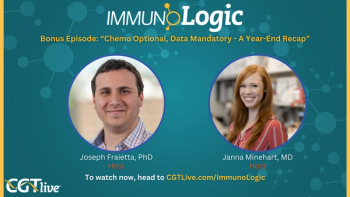
Hemophilia A Gene Therapy Yields Sustained Bleeding Reductions in Severe Cases
Reductions in annualized bleeding rate remained significant at 2 years in the phase 3 study although recently presented phase 2 data showed significant FVIII reductions at 5 years.
Biomarin's investigative gene therapy
In 112 treated participants from a prior non-interventional study, annualized Factor VIII (FVIII) infusion rate was significantly reduced by a mean of 133 infusions per year (P <.0001; 98%) from baseline. Annualized Bleeding Rate (ABR) was significantly reduced by 4.1 treated bleeds per year (P <.0001; 85%) from a baseline mean of 4.8 (median, 2.8) in this population.
"A potential single treatment that provides a durable response for years could be a game-changer by offering a transformative treatment choice beyond existing therapies and addressing an unmet medical need for people with hemophilia A," investigators Steven W. Pipe, MD, professor, pediatrics and pathology, University of Michigan, said in a statement.1 "As a principal investigator, I have witnessed the transformative liberating potential of valoctocogeneroxaparvovec for hemophilia A in my own clinical trial participants. I'm delighted to see these results broadly confirmed in the largest study of its kind."
Overall, in the treated population, mean ABR was 0.8 (median, 0.0) throughout the evaluation period. Mean ABR was 0.9 (median, 0.0) during the first year and 0.7 (median, 0.0) during the second year. Mean annualized infusion rate (AIR) was 2.6 (median, 0.0) throughout, 1.5 (median, 0.0) during the first year and 3.4 (median, 0.0) during the second year.
READ MORE:
Mean endogenous FVIII activity was 23.0 IU/dL (median, 11.8) as measured by chromogenic substrate (CS) assay in treated participants at the end of the second year and 36.1 IU/dL (median, 21.6) as measured by one-stage (OS) assay.
In a subset of 17 patients dosed for at least 3 years, mean FVIII activity was 16.8 IU/dL (median, 9.3) as measured by CS assay and 27.0 IU/dL (median, 19.1) as measured by OS assay at the end of the third year. These patients had a mean cumulative ABR of 0.7 (median, 0.0) at a median follow-up of 174 weeks and and a mean cumulative ABR of 0.6 (median, 0.0) during the third year.
Valoctocogene roxaparvovec has been well-tolerated in treated patients, all of whom have received a 6e13 vg/kg dose. The most common treatment- or infusion-related adverse event (AEs) was alanine aminotransferase elevations, which occurred in 89% (n = 119) of participants. Other common AEs included headache, arthralgia, nausea, aspartate aminotransferase elevations, and fatigue.
No participants developed FVIII inhibitors, malignancy, or thromboembolic events, and no new safety signals or treatment-related serious AEs were reported during year 2 of the study. In terms of corticosteroid use, most patients discontinued use during the first year and no serious AEs related to their use were reported in patients using corticosteroids during the second year.
"We are delighted that our perseverance on behalf of people with hemophilia A has led to today's transformative results in the largest gene therapy study for hemophilia A," Hank Fuchs, MD, president, worldwide research and development, BioMarin, added to the statement.1 "We are grateful for the support of the bleeding disorders community to conduct this clinical program. These results show that valoctocogeneroxaparvovec could profoundly change the way hemophilia A is treated. We are looking forward to continuing to work with health authorities to bring this therapy to patients with hemophilia A."
The FDA previously granted valoctocogene roxaparvovec regenerative medicine advanced therapy, breakthrough therapy, and orphan drug designations. The EMA has also granted the gene therapy orphan drug designation.
The European Committee for Medicinal Products for Human Use and Committee for Advanced Therapies’ decision is anticipated in the first half of 2022. The FDA has requested 2-year follow-up safety and efficacy data from the GENEr8-1 study for resubmission of a biologics license application, which is being targeted for the second quarter of 2022.
Previous data from phase 1/2 study (NCT04684940) of valoctocogene roxaparvovec presented at the
Participants in both high- and low-dose (4e13 vg/kg) cohorts experienced substantial decline in levels of endogenous FVIII expression as confirmed by both CS and OS assays. Participants that received the high-dose being investigated in the GENEr8-1 study had FVIII expression decrease from a mean of 11.6 IU/dL (SD, 12.2) to a median of 8.2 IU/dL at 5 years via CS assay and from a mean of 18.7 IU/dL (SD, 17.5) to a median of 15.7 IU/dL after 5 years via OS assay.
As of the most recent follow-up, some participants have had unquantifiable FVIII expression by CS assay, while other participants are in the mild-to-moderate hemophiliac range and 1 participant is in the non-hemophiliac range.
"We are optimistic that ABR may be maintained acceptably low through years 3, 4, and 5 after treatment with valrox in the GENEr8-1 study given the predictable, and not sudden or dramatic, change in Factor VIII expression in the later years following treatment in the Phase 1/2 study," Fuchs said in a previous statement.2 "The data show excellent hemostatic efficacy in the 6e13 and 4e13 vg/kg dose cohorts, which is maintained into year 5 and 4, respectively.”
REFERENCES
1. BioMarin announces stable and durable annualized bleed control in the largest phase 3 gene therapy study in adults with severe hemophilia A; 134-participant study met all primary and secondary efficacy endpoints at two year analysis. News release. BioMarin. January 9, 2022. https://www.prnewswire.com/news-releases/biomarin-announces-stable-and-durable-annualized-bleed-control-in-the-largest-phase-3-gene-therapy-study-in-adults-with-severe-hemophilia-a-134-participant-study-met-all-primary-and-secondary-efficacy-endpoints-at-two-year-analys-301456772.html
2. BioMarin announces oral presentation at ISTH 2021 Virtual Congress with 5 years of clinical data from ongoing phase 1/2 study of valoctocogeneroxaparvovec in adults with severe hemophilia a, demonstrating continued, durable clinical benefit. News release. BioMarin. July 21, 2021. https://www.biospace.com/article/releases/biomarin-announces-oral-presentation-at-isth-2021-virtual-congress-with-5-years-of-clinical-data-from-ongoing-phase-1-2-study-of-valoctocogene-roxaparvovec-in-adults-with-severe-hemophilia-a-demonstrating-continued-durable-clinical-benefit/
Newsletter
Stay at the forefront of cutting-edge science with CGT—your direct line to expert insights, breakthrough data, and real-time coverage of the latest advancements in cell and gene therapy.




































